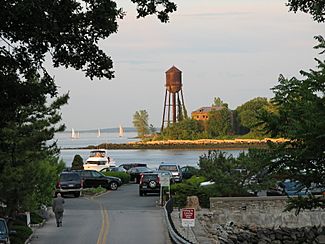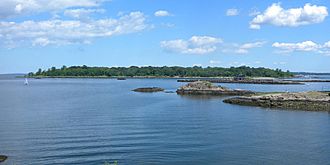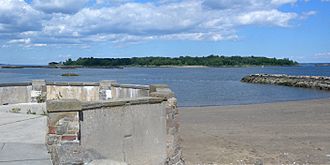Davids Island (New York) facts for kids

Pre-2008 view of the northern end of Davids Island
|
|
|
Location of Davids Island off the coast of New Rochelle
|
|
| Geography | |
|---|---|
| Location | Long Island Sound |
| Coordinates | 40°53′00″N 73°46′13″W / 40.883417°N 73.770231°W |
| Area | 78 acres (32 ha) |
| Administration | |
|
United States
|
|
| State | New York |
| County | Westchester County |
| City | New Rochelle |
Davids Island is a 78-acre island. It is located off the coast of New Rochelle, New York. This island is in Long Island Sound. Today, no one lives on the island. But it used to be the site of Fort Slocum, a military base.
The island is a home for many animals. These include the endangered Kemp's ridley sea turtle. Birds like osprey and least terns also live there. Davids Island has important wetlands. It also has rare rocky areas and sandy beaches. The waters around the island are full of fish. You can find winter flounder, Atlantic herring, and Atlantic silverside there.
Contents
What's in a Name?
The island's name is often confused. Some people call it "David Hawk's" Island. But this is not correct. The island is named after Thaddeus Davids. He was an ink maker from New York City. He owned the island before the Army bought it.
The U.S. government first leased the island in 1861. They then bought it in 1867. It was called "Davids Island Military Reservation." On July 1, 1896, its name changed to "Fort Slocum." Before Thaddeus Davids, the island had many other names. It was named after its different owners. These names included Bouteillier's, Rodman's, and Morse's Island.
A Look Back in Time
Davids Island has a long history. Long ago, Native Americans lived there. This was before European explorers arrived. By the mid-1600s, the Siwanoy people lived in the New Rochelle area.
Archaeologists have found proof of Native Americans on Davids Island. They lived there between 1,000 and 1,500 AD. In the 1600s, Native Americans started to leave New York's coast. This was because European traders came to the area. In 1654, Thomas Pell bought the land. This land included Davids Island. He bought it from the Siwanoy people.
Early European Settlers
From colonial times until the mid-1800s, Davids Island was used for farming. People also kept animals there. European settlers called Huguenots arrived in the late 1600s. They were the first permanent European residents.
By the mid-1800s, steamboats brought people to New Rochelle. City dwellers from New York City came for fun. They wanted to escape the busy city. Davids Island was a regular stop for these boats. So were Neptune and Glen Island.
The Civil War Hospital
In November 1856, Thaddeus Davids bought the island. He planned to move his ink factory there. But he never did. In 1862, he leased the island. It was then subleased to the U.S. War Department. They needed it for a hospital.
Soon, De Camp General Hospital was built. Wooden buildings were put up. They housed thousands of wounded soldiers. These soldiers were prisoners from the Civil War. By late 1862, De Camp was the Army's largest hospital. It held over 2,100 patients.
At first, only Union soldiers were treated there. But after the Battle of Gettysburg in July 1863, things changed. The hospital began caring for wounded Confederate soldiers. Davids Island soon held over 2,500 Confederate prisoners. Most got better by October. They were then moved to other prisoner of war camps.
A ferry connected Davids Island to Neptune Island. After the war, the government bought Davids Island. This was in 1867. From then on, the government ran its own ferry. In 1878, Davids Island became a main place for Army recruiting. It was a training center for many years.
Fort Slocum: A Military Base
Later, the island became a coastal artillery defense post. It was named Fort Slocum. This was in honor of Major General Henry W. Slocum. Between 1891 and 1904, big guns were placed on the island. These were for defense.
At the start of the 1900s, the island became an important meeting point. Soldiers gathered there before going overseas. By World War I, it was a very busy recruiting station. About 100,000 soldiers passed through each year.
From 1946 to 1949, Fort Slocum was the home of the First Air Force. In June 1949, it was called "Slocum Air Force Base." But this only lasted a year. In June 1950, it became an Army post again. From 1955 to 1960, Fort Slocum had a Nike Ajax air-defense battery. These were missiles to protect the sky. The missiles were stored on Hart Island. The radar and control base were on Davids Island. But in July 1960, the Nike Battery closed.
In April 1951, the U.S. Army Chaplain School moved to Fort Slocum. It was the main group on the base until 1962. Four Army ferry boats connected the base to the mainland. Two large boats carried people, cars, and trucks. Two smaller boats carried only people. These smaller boats were also used for trips. They took troops and their families to the 1964 N.Y. World Fair.
In the mid-1960s, the government looked for ways to save money. Secretary of Defense Robert McNamara studied military bases. Fort Slocum was chosen to be closed. Fort Slocum was officially shut down on November 30, 1965. After that, the buildings on the island were left alone. They became very run down.
What Happened Next?
In 1967, the city of New Rochelle bought Davids Island. They used it for a summer camp for kids. In 1968, Consolidated Edison (Con Ed) bought the island. They paid three million dollars. Con Ed wanted to build a nuclear power plant there. But they changed their plans in 1973. They sold the island back to New Rochelle in 1976 for just $1.
By 1977, the island had been neglected for ten years. New Rochelle decided to make it an urban renewal area. This meant they wanted to fix it up.
Plans for the Island
In 1981, a company called Xanadu Properties Associates wanted to rebuild Davids Island. Their plans included a bridge and a large marina. They also wanted to build 2,000 fancy apartments. But these plans were very big. Many people in the public did not like them.
In 1987, a group called Save Davids Island for the Citizens formed. They were against Xanadu's plans. State officials also worried about public access to the shoreline. In 1992, New Rochelle decided not to work with Xanadu anymore. They looked for new ideas. Developer Donald Trump briefly showed interest. But his plans did not go far.
The old buildings of Fort Slocum stayed on Davids Island. They made it hard to redevelop the island. But in 2004, Congress gave money to remove the ruins. This was part of a Defense Department program. It helps communities reuse old military sites. In the summer of 2008, New Rochelle tore down all the remaining buildings. This included the famous water tower. The city plans to turn the island into a park.
Gallery
-
View of island from Glen Island





